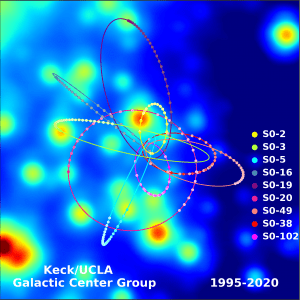A study of massive and very bright stars close to the center of our galaxy has found something unexpected: these stars are much less likely to be parts of binary or triple systems than those in Earth’s vicinity.
Being close to many others of your kind might seem to maximize hook-up chances, but if you take your dating advice from the stars (astronomy not astrology), crowds leave you more likely to end up alone.
Galaxies resemble human communities in that they are packed towards the center and get sparser further out; it’s one of the reasons people sometimes refer to them as cities of stars. Out in the galactic suburbs where the Sun resides most stars orbit each other in binary systems, with some triples or even more elaborate systems. The Sun is a relative rarity, which some astronomers think lost a partner in an early divorce.
However, a 10-year survey of the galactic center, published recently, reports that’s not the case near the galactic heart. UCLA’s Dr Devin Chu and colleagues investigated so-called “S-stars”, named for their proximity to Sagittarius A*, the supermassive black hole at the center of the galaxy.

View of the area around the black hole at the center of the galaxy with stars’ orbits marked.
Image credit: Galactic Center Orbits Initiative/W. M. Keck Observatory
S-stars jostle each other closely compared to our region, where even the nearest stars are light-years away. We might expect this to lead to even stars that don’t form together getting entwined by each other’s gravity. It’s hard to make out small faint stars at a distance of 26,000 light-years when overshadowed by brighter objects, so Chu’s team mostly found giants more than 10 times as massive as the Sun. These stars burn brightly – they’re thousands as times as luminous as the Sun – and have short lives.
In the galactic arms, or the spaces between, hot stars like this are even more likely to have a companion on their arm – if they’re not in an Alpha Centauri-style throuple – than our smaller neighbors. However, the paper concludes a maximum of 47 percent of stars in the Sagittarius A* vicinity could have one or more companions, compared to 70 percent in the galaxy as a whole.
“This discovery speaks to the incredibly interesting environment of the Galactic Center,” Chu said in a statement. “It is likely the supermassive black hole’s powerful influence causes binary star systems to either merge or become disrupted, where a companion star gets kicked out from the region.” Perhaps it’s not that stars cannot find their match in the busy core, but forces there are too strong to let them stay together. Someone warn Carrie Bradshaw.
Admittedly, Chu’s sample is quite small – just 28 stars, of which 16 were B-type giants. However, the fact that not one of this group shows the changes in radial velocity associated with having a stellar companion makes the 47 percent figure a ceiling not a floor.
Arguably the real wonder, however, is that there are any stars this close to Sagittarius A* at all, as the powerful gravitational forces from such a massive object should disrupt their formation. The few older stars in Chu’s sample might have migrated in from safer environments, but the younger members haven’t had time to travel very far. How the S-star cluster exists at all has been a matter of debate for more than 30 years.
The study is published open access in The Astrophysical Journal.
Source Link: Why Even Hot Stars Are Lonely Near The Galactic Center